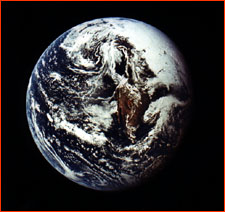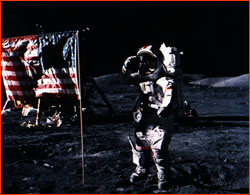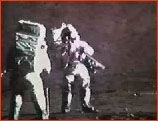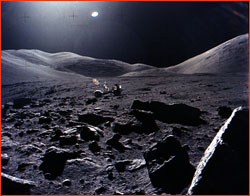 |
 |
 |
Part 2 | Back to Part 1 Flying to the Moon (Apollo 10) There was more than enough time for me to become contemplative and again ask myself that question I pondered so often in space: Is it possible that this was really happening to me? Obviously it was, but the power of the situation was simply overwhelming. One result of space travel was that I had become much more philosophical, at times unable even to focus on minor problems back on Earth because they just seemed so small in comparison to what I had experienced and the places I had been. My fellow astronauts who went to the moon encountered varying degrees of the same disease; we broke the familiar matrix of life and couldn't repair it. For instance, looking back at Earth, I saw only a distant blue-and-white star. There were oceans down there, deep and wide, but I could see completely across them now and they seemed so small. However deep, however wide, the sea has a shore and a bottom. Out where I was dashing through space, I was wrapped in infinity. Even the word "infinity" lost meaning, because I couldn't measure it, and without sunsets and sunrises, time meant nothing more than performing some checklist function at a specific point in the mission. Beyond that star over there, Alpheratz, is another and another. And over there, beyond Nunki, the same thing. Behind Formalhaut, even more stars, stretching beyong my imagination. Stars and eternal distant blackness everywhere. There is no end. I'm not an overly religious person, but I certainly am a believer, and when I looked around, I saw beauty, not emptiness. No one in their right mind can see such a sight and deny the spirituality of the experience, nor the existence of a Supreme Being, whether their God be Buddha or Jesus Christ or Whoever. The name is less important than the acceptance of a Creator. Someone, some being, some power placed our little world, our sun, and our moon where they are in the dark void, and the scheme defies any attempt at logic. It is just too perfect and beautiful to have happened by accident. I can't tell you how or why it exists in this special way, only that it does, and I know that for certain because I have been out there and I have seen the endlessness of space and time with my own eyes.
I scanned for an empty space in a parking lot of boulders as big as automobiles, and was concerned the powerful LM [Lunar Module] engine might kick up a cloud of black dust that would blot my view. Instead, there was very little, and I was able to eyeball the landing site. So close to the valley floor, those surrounding massifs seemed damned big! The sheer North Massif to our right stood as tall as eight-and-a-half Eiffel Towers and to the left, the wretched slab of the South Massif would equal the height of about seven Empire State Buildings stacked one atop the other. A determined Jack [Schmitt, the LM pilot and a geologist, the only scientist to go to the moon] stayed with his readouts. "Move her forward a little. Ninety feet. Little forward velocity. Eighty feet, going down at three [feet per second]. Getting a little dust. We're at 60 feet, going down at about two. Very little dust. Very little dust, 40 feet, going down at three." Almost there. I steadied the lander for the final hop as charcoal-gray dust rose up and roiled about the windows, obscuring the view. "Stand by for touchdown." "Standing by. Twenty-five feet, down at two," Jack said with tense words. "Fuel's good. Twenty feet. Going down at two. Ten feet . . . ." Wire sensors nine feet long trailed from the pads of the lander legs, and when one brushed the surface, a blue light flashed on my console and I shut down the rocket. We dropped the last few feet with a stomach-flipping thud, jolted once, and came to rest slightly tilted in a shallow depression. We were only 200 feet from the precise place picked as a target months ago on Earth. It was 1:54 P.M. Houston time on December 11, 1972, and four days, 14 hours, 22 minutes, and 11 seconds had elapsed since we had blasted off from Florida. I paused for a moment and slowly exhaled after making one of the smoothest landings of my career. More than two and a half hours of unrelenting dynamic action and steely tension had drained my senses since we had undocked from America [the command module], and now everything came to an abrupt stop. Instant silence reigned. Not a word from Jack, who was as stunned as I, no pounding rocket, no vibration, no noise. Not the song of a bird, the bark of a dog, not a whisper of wind or any familiar sound from my entire life. I was totally enveloped by such a thorough and complete stillness that I have difficulty comprehending it even today. The only sound inside my helmet was my labored breath, and even that slight disturbance seemed so terribly intrusive that for a brief moment, I stopped breathing, too. Then there was nothing at all. I broke the spell. "Okay, Houston, the Challenger has landed!" I joyfully reported and pried my cramped hands from the thruster controls. "Yes sir, we is here. Tell America that Challenger is at Taurus-Littrow [the designated landing site]." Above the South Massif, the Earth stood still in the inky southwestern sky, my silent, guardian star.
Dreams really do come true. Four hours after landing on the moon and wearing the backpack that contained my life-support system, I wriggled backward through the tiny hatch, got to my knees on the small porch, and cautiously descended Challenger's ladder, a rung at a time, until I stood on the saucerlike footpad. The sun glared bright all around as I had my first good look at the vast emptiness, while the canopy of sky remained thickly black from horizon to horizon, a contradiction that played How can this be? with my logical mind. No fear, no apprehension, but a tremendous sense of satisfaction and accomplishment welled within me. My size-10-1/2 boot was poised just inches above the surface of this almost mythical land that mankind had watched so closely for uncounted eons and to which we had assigned properties ranging from religious icon and symbol of romance to maker of werewolves and clock for the harvest. Every night of my life it had been up there, patiently waiting for my visit. I lowered my left foot and the thin crust gave way. Soft contact. There, it was done. A Cernan bootprint was on the moon. I had fulfilled my dream. No one could ever take this moment away. "As I step off at the surface of Taurus-Littrow, I'd like to dedicate the first steps of Apollo 17 to all those who made it possible," I called to Houston. "Oh, my golly. Unbelievable." My God, I was standing in a place no one had ever been before. The soil that was firmly supporting me was not the dirt of the Earth, but of a different celestial body, and it glittered in the bright sun as if studded with millions of tiny diamonds. The sun, low in the lunar morning sky, cast a long shadow beyond the parked Challenger. I slowly pivoted, trying to see everything, and was overwhelmed by the silent, majestic solitude. Not so much as a squirrel track to indicate any sort of life, not a green blade of grass to color the bland, stark beauty, not a cloud overhead, or the slightest hint of a brook or stream. But I felt comfortable, as if I belonged here. From where I stood on the floor of this beautiful mountain-ringed valley that seemed frozen in time, the looming massifs on either side were not menacing at all. It was as if they, too, had been awaiting the day someone would come and take a walk in their valley. I wasn't worried about what might happen next, whether some unknown danger lurked at my elbow, nor did I give much thought about how we would get out of this place when the time came. We had gotten here, and we would get home. For the next three days, I planned to live my life to the fullest, to milk every moment of this rare and wonderful existence.
Back at Challenger, we dusted each other off, loaded our final boxes of rocks, then Jack climbed the ladder and disappeared into the hatch. By then, we had stayed longer and traveled further on the surface of the moon than any other crew. We had covered about 19 miles and collected more than 220 pounds of rock samples and, even before we were aboard, scientists in Houston were crowing that this had been the most meaningful lunar exploration ever. We were living proof that the Apollo program had paid dividends. While Jack cleaned up inside, I drove the Rover about a mile away from the LM and parked it carefully so the television camera could photograph our takeoff the next day. As I dismounted, I took a moment to kneel and with a single finger, scratched [my daughter] Tracy's initials, T D C, in the lunar dust, knowing those three letters would remain there undisturbed for more years than anyone could imagine. Alone on the surface, I hopped and skipped my way back to Challenger, my thoughts racing wildly as I sought to encompass this experience. Just being there was a triumph of science to be celebrated for ages, but it was more than a personal dream come true, for I felt that I represented all humanity. There was a sense of eternity about Apollo. Sir Isaac Newton once said, "If I have been able to see farther than others, it is because I stood on the shoulders of giants." Every man and woman who put in long hours to get us to the moon now stood with me beside the lunar lander in that odd sun-washed darkness. Every astronaut who had gone into space, who made it possible for me to fly a little higher, stay a little longer, was at my side. These were the giants upon whose shoulders I stood as I reached for the stars. I could almost feel the presence of [Roger Chaffee, Gus Grissom, and Ed White, the astronauts of Apollo 1 who died in a launchpad fire], and all other astronauts and cosmonauts who died in the pursuit of the moon. We had carried on in their names. I took one last unfiltered look at the Earth and was enveloped by a sense of selfishness, for I was unable to adequately share what I felt. I wanted everyone on my home planet to experience this magnificent feeling of actually being on the moon. That was not technologically possible, and I knew it, but there was a bit of guilt at being the Chosen One. I put a foot on the pad and grabbed the ladder. I knew that I had changed in the past three days, and that I no longer belonged solely to the Earth. Forever more, I would belong to the universe. Photos: NASA Explore the Moon | Lunar Puzzlers | Last Man on the Moon Hear the Space Pioneers | Origins | Resources Transcript | Site Map | To the Moon Home Editor's Picks | Previous Sites | Join Us/E-mail | TV/Web Schedule About NOVA | Teachers | Site Map | Shop | Jobs | Search | To print PBS Online | NOVA Online | WGBH © | Updated November 2000 |
 The Apollo 10 crew shot this view of the Gulf of
California from 36,000 miles away, as they sped towards their orbit of the moon
in May 1969.
The Apollo 10 crew shot this view of the Gulf of
California from 36,000 miles away, as they sped towards their orbit of the moon
in May 1969.
 Gene Cernan salutes the American flag, which
partially obscures the Lunar Module.
Gene Cernan salutes the American flag, which
partially obscures the Lunar Module.
 Listen to Gene Cernan talk about "one of the most proud moments of my
life," as he and Jack Schmitt plant the American flag on the moon's
surface.
Listen to Gene Cernan talk about "one of the most proud moments of my
life," as he and Jack Schmitt plant the American flag on the moon's
surface. Apollo 17's Lunar Rover was left on the moon, eternal
testimony to a successful mission—our last, Cernan wrote, "for too many
years to come."
Apollo 17's Lunar Rover was left on the moon, eternal
testimony to a successful mission—our last, Cernan wrote, "for too many
years to come."